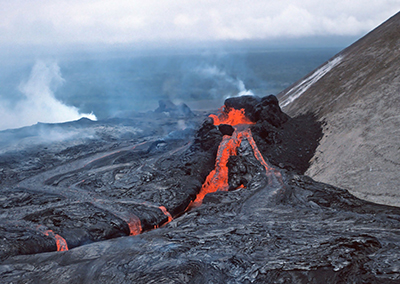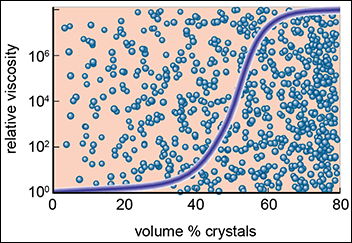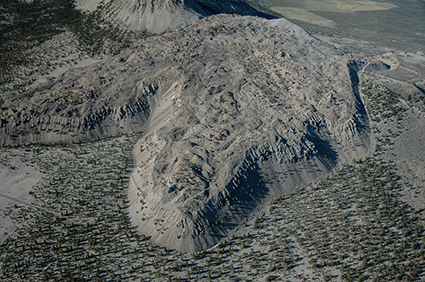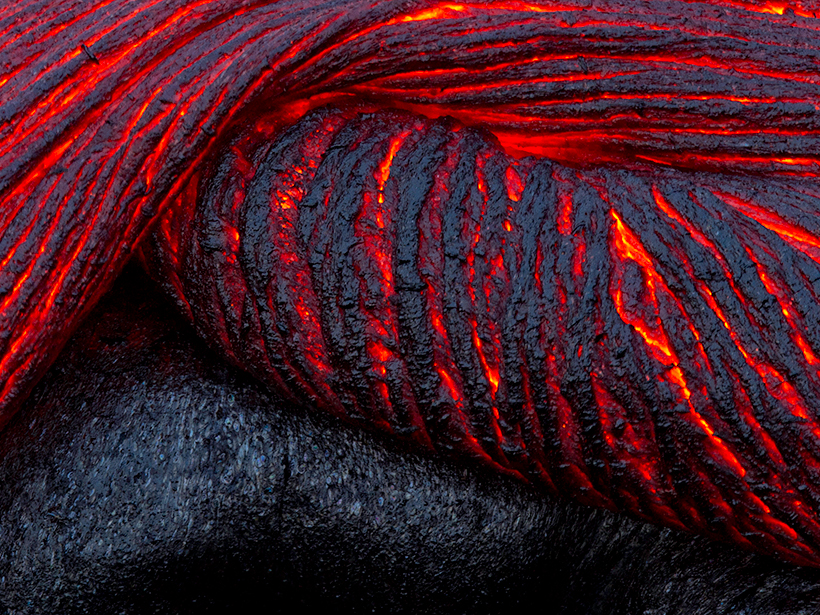“Magma,” definition 5: A confused or disordered body or mass of something.
—Oxford English Dictionary Online (20 September 2016)
Magma is a fundamental constituent of the Earth. Issues as diverse as volcanic hazard assessment and planetary evolution studies rely on knowledge of magma’s properties, origin, evolution, and significance. Thus, the definition of “magma” should be simple and universally agreed upon, but the term means fundamentally different things to different people.
This inconsistency has led to miscommunication between petrologists, geophysicists, the press, and the public, making the “confused or disordered” definition of the word unintentionally appropriate. It is time to agree on a clearer geologic definition of “magma.”
To the public, magma is the stuff of lava—hot, glowing red liquid that flows out of volcanoes—and such lava is unquestionably magma that has reached the surface. The point of contention is whether partially molten rock that resides below the surface and is too crystalline to flow should also be called magma.
Because this distinction is critical when geologists communicate about magma, especially to the press and public, we contend that highly crystalline immobile material should not be called “magma.” Rather, magma should mean material that is capable of moving within the Earth and onto its surface.
Can Magma Be Mostly Solid?
“Magma” is commonly used to mean any rock that is at least a little bit molten. For example, a recent seismic study of areas around Yellowstone National Park published in Science [Huang et al., 2015] reported a “lower-crustal magma body [that] has a volume of 46,000 cubic kilometers.” That is a lot of magma!

Several national news outlets picked up on this figure, including National Public Radio, NBC News, the Washington Post, and Fox News. All of them reported that there is enough magma “to fill the Grand Canyon 11 times.”
This may have created a public perception of a vast pool of liquid perched under Yellowstone, waiting to explode. However, the authors of the scientific study were careful to note that nothing has changed—the amount of molten material under Yellowstone is the same, and the risk has not changed—but they had produced an improved image of the partially molten rock.
The study also noted that this large volume in their image contains only a small percentage of molten material. That is still a lot of melt—enough to fill 20% of the Grand Canyon—but it is dispersed through a large volume of rock, not gathered for an eruption. It is unlikely that the features that Huang’s group imaged could produce an eruption unless the molten material were collected into a much smaller volume with a much higher melt fraction.
What’s in a Name?
Whether rock that contains a small percentage of partial melt should be called magma is debatable. Indeed, use of the word “magma” to refer both to material that can flow across the Earth’s surface and to a largely solid volume that contains a small fraction of melt is akin to using the same word to refer to a river and to an aquifer. To do so ignores and obscures fundamental differences, and broad usage of “magma” is clearly causing such conceptual problems.
Current use of “magma” is akin to using the same word to refer to a river and to an aquifer.
The term “magma” was used in pharmacy as early as the 17th century for suspensions such as magnesia magma (now called milk of magnesia). George Scrope was among the first to use the term in a geological context [Scrope, 1862, p. 121]. He wrote that lava “is not a homogeneous molecular liquid, such as any melted or completely fused substance, but … a ‘magma’ or compound of crystalline or granular particles to which a certain mobility is given by an interstitial fluid.” Scrope clearly viewed the ability to flow or intrude as a defining quality.
Should I Stay or Should I Flow?
A critical control on mobility in a crystal-liquid mixture is the volume ratio of crystals to liquid; the apparent viscosity of a mixture (the ratio of how much shear stress is applied to the rate at which the material deforms) depends upon the proportion of particles suspended in it. For a low percentage of solid particles, less than 20% by volume, for example, the particles are sufficiently dispersed that they scarcely interact during flow.

However, when the percentage of particles reaches approximately 40%–60% by volume, the apparent viscosity of the suspension increases by several orders of magnitude as crystals lock up and jam together. Crystals within these logjams hold each other in place in a phenomenon called force chains [Cates et al., 1998], and the system transitions from a melt with suspended crystals to a crystal network with interstitial melt (Figure 1) [Lejeune and Richet, 1995].
During cooling, crystals grow onto one another and interlock to produce a welded framework that is even stronger than one produced by nonreactive particles such as pebbles in water. Such a material can only flow by processes such as crystal plasticity and solution-reprecipitation, at rates dramatically slower than those at which even highly viscous silica-rich melts can flow. Collecting melt from such a material is a slow process.
Two Names for Two Materials
This fundamental difference in deformation and flow (rheology) between partially molten rock that is melt rich (more than about 50% melt by volume) and its melt-poor counterpart (less than about 50%) is reason to give the two materials different names. Here we suggest that the term “magma” be reserved for melt-rich materials that can flow as fluids on timescales consonant with volcanic eruptions. We suggest that more crystal-rich and largely immobile partially molten rock be referred to by another name such as “crystal mush” or “rigid sponge” [Hildreth, 2004].
By this definition, highly viscous materials such as water-poor rhyolite lavas (Figure 2), with viscosities that can reach 1010 pascal seconds or greater [Pinkerton and Stevenson, 1992], are magma, whereas highly crystal rich materials are not. The former can ascend to the Earth’s surface sufficiently rapidly to be erupted, whereas the latter cannot. This is consistent with the general observation that volcanic rocks with more than about 50% crystals by volume are rare [Marsh, 1981].

This distinction is not, and cannot be, precise, yet it is useful for reasons both internal and external to the magma community. For example, many interpretations of plutonic rocks depend on the inferred existence of large bodies of melt-rich magma in which processes such as crystal settling play out—the “big tank” model, illustrated in myriad textbooks and papers. Such processes are largely impossible in a system such as the body imaged under Yellowstone, which consists of more than 90% solid rock with melt in its pore spaces. The magma research community intuitively understands this distinction, but using “magma” as a one-size-fits-all term for rock with any proportion of melt obscures it.
For the press, the public, and even Earth scientists who do not specialize in magmatic systems, “magma” conjures up dramatic images of lava flowing down hillsides. Using the same term to describe large rock volumes that contain small melt fractions as well as large bodies of mobile magma can engender such mistaken perceptions as a sea of potentially eruptible magma underneath Yellowstone.
A Better Definition
We want to start a conversation about a more precise definition of “magma.” We suggest this as a starting point:
Magma: naturally occurring, fully or partially molten rock material generated within a planetary body, consisting of melt with or without crystals and gas bubbles and containing a high enough proportion of melt to be capable of intrusion and extrusion.
This proposed definition naturally reflects our particular scientific perspective and concerns; we hope that it will stimulate a broad-based discussion that will yield a consensus definition.
Acknowledgments
Conversations with numerous geologists and geophysicists over the years have helped to clarify various viewpoints about the meaning of “magma,” and Christoph Breitkreuz and Bernard Bonin offered interesting German and French perspectives. Comments by anonymous reviewers are greatly appreciated. Supported by NSF grant EAR-1250505 to A.F.G.
References
Cates, M. E., J. P. Wittmer, J.-P. Buchaud, and P. Claudin (1998), Jamming, force chains and fragile matter, Phys. Rev. Lett., 81, 1841–1844.
Hildreth, W. (2004), Volcanological perspectives on Long Valley, Mammoth Mountain, and Mono Craters: Several contiguous but discrete systems, J. Volcanol. Geotherm. Res., 136(3–4), 169–198.
Huang, H.-H., F.-C. Lin, B. Schmandt, J. Farrell, R. B. Smith, and V. C. Tsai (2015), The Yellowstone magmatic system from the mantle plume to the upper crust, Science, 348(6236), 773–776.
Lejeune, A., and P. Richet (1995), Rheology of crystal-bearing silicate melts: An experimental study at high viscosities, J. Geophys. Res., 100, 4215–4229.
Marsh, B. D. (1981), On the crystallinity, probability of occurrence, and rheology of lava and magma, Contrib. Mineral. Petrol., 78, 85–98.
Pinkerton, H., and R. J. Stevenson (1992), Methods of determining the rheological properties of magma at sub-liquidus temperatures, J. Volcanol. Geotherm. Res., 53, 47–66.
Scrope, G. P. (1862), Volcanos: The Character of Their Phenomena, Their Share in the Structure and Composition of the Surface of the Globe, and Their Relation to Its Internal Forces; with a Descriptive Catalogue of All Known Volcanos and Volcanic Formations; with a Map of the Volcanic Areas of the Globe, 490 pp., Longman, Green, Longmans, and Roberts, London.
—Allen F. Glazner, Department of Geological Sciences, University of North Carolina at Chapel Hill, Chapel Hill; email: [email protected]; John M. Bartley, Department of Geology and Geophysics, University of Utah, Salt Lake City; and Drew S. Coleman, Department of Geological Sciences, University of North Carolina at Chapel Hill, Chapel Hill
Citation:
Glazner, A. F.,Bartley, J. M., and Coleman, D. S. (2016), We need a new definition for magma, Eos, 97, https://doi.org/10.1029/2016EO059741. Published on 22 September 2016.
Text © 2016. The authors. CC BY-NC-ND 3.0
Except where otherwise noted, images are subject to copyright. Any reuse without express permission from the copyright owner is prohibited.

